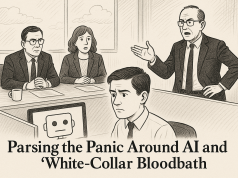In a world that consistently gravitates towards novelty and disruption, organizations are finding themselves at a crossroads. The Age of Innovation demands a workplace that brims with creative thinking, yet the timeless principles of structure and control cannot be dismissed. Leaders are the conductors of this complex orchestra, faced with the Herculean task of harmonizing the free flow of ideas with the metronomic precision needed for operational success.
Striking the balance between creativity and control is akin to walking a tightrope. Lean too much on control, and you risk stifling the very innovation that propels your organization forward. Tip too far towards unfettered creativity, and you may find your team meandering through a forest of ideas without a clear path out.
Leaders must, therefore, embrace strategies that allow for the blossoming of creativity while safeguarding the rigidity of control. It begins with shaping a culture that equally celebrates the eureka moments and the disciplined execution of those ideas. Instituting frameworks like Google’s ‘20% time’ concept, where employees are encouraged to dedicate a portion of their workweek to pursue passion projects, has been seminal in showcasing how autonomy can coexist with accountability.
Moreover, leaders can inspire innovation by setting ‘innovation intentions.’ These are clear goals that define what innovation looks like for the team, coupled with the boundaries within which it should operate. This clarifies expectations, enabling team members to explore creatively within a safe and defined sandbox, reducing the potential for unchecked risk-taking.
Yet, even the most innovative cultures must navigate the realities of risk management. Leaders are tasked with the intricate dance of encouraging boldness while mitigating potential fallout. Companies like 3M and Pixar provide exemplary templates. They conduct ‘post-mortems’ on both successes and failures, learning and iterating without blame, and treating each project as a stepping stone toward relentless improvement.
In this delicate ecosystem, communication is the lifeline. Transparent dialogue about the company’s strategic direction, risks, and boundaries ensures everyone is aligned and moving in concert. It also builds trust — a critical element in fostering a safe space for sharing unconventional ideas.
Reflecting on the corporate landscape, we see a spectrum. On one end are companies that have cracked the code, like IDEO, where a culture of design thinking has led to breakthrough innovations while maintaining operational excellence. On the other, there are cautionary tales of businesses that either resisted the tide of creativity and became obsolete or those that embraced innovation without discipline, only to see their ventures collapse under the weight of unmanaged chaos.
As we peer into the future, the implications for leadership models are profound. The leaders of tomorrow will have to be ambidextrous, adept both at igniting the creative spark and at harnessing it. They will need to be fluent in the language of innovation, yet literate in the lexicon of risk and control. The emergence of such leadership will not be a luxury but a necessity, as creativity becomes the currency of a competitive advantage.
In conclusion, the paradox of leadership in the Age of Innovation may be complex, but it is not insurmountable. With thoughtful approaches that value both the beauty of a wild idea and the strength of a steady hand, leaders can write symphonies of success that resonate across the expanse of the modern workplace.



















![From TAOLabs: A New, Simplified Way to Learn in the Age of Chaos [30m60h90d] From TAOLabs: A New, Simplified Way to Learn in the Age of Chaos](https://theworktimes.com/wp-content/uploads/2025/05/ChatGPT-Image-May-13-2025-01_11_22-AM-238x178.png)








